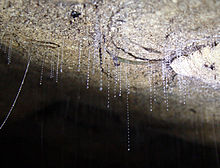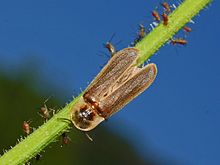Glow worm is the common name for various groups of insect larvae and adult larviform females that glow through bioluminescence. They may sometimes resemble worms, but all are insects (Arachnocampa and Orfelia being flies and all the others being beetles).
Classification

Order: Coleoptera (Beetles)
Major families are:
- Lampyridae (fireflies), found around the world. The wingless adult female is the glowworm of literature, especially Lampyris noctiluca (the "Glow-worm" proper of British English) found in most of Europe. In this species the male flies but does not glow. A glow worm looks like a female firefly without wings. In some areas, a Firefly can also refer to members of the Luciola genus in the same family, found commonly throughout Europe, in which both the males and the flightless females glow.
- Phengodidae, found in North America and South America
- Rhagophthalmidae, found in Asia
- Keroplatidae (flies, order Diptera): the genus Arachnocampa (formerly called Bolitiphila), found in New Zealand and Australia
- Mycetophilidae (flies, order Diptera): Orfelia fultoni ("dismalites"), a single species of fungus gnat, distantly related to Arachnocampa, found in North America.
Groups include:
- Lampyridae
- Phengodidae
- Railroad worm
- Arachnocampa
- Orfelia fultoni
Glow
The glow worm is a yellow-green colour worm. The so-called railroad worms in the Phengodidae family have an additional red light at their head. The fly larvae produce a blue-green colour. The glow is produced by different organs in the different families, suggesting they evolved separately, though several other beetle families in the superfamily Cantharoidea also exhibit bioluminescence, suggesting a single origin within this lineage and hence that the Lampyrids and Phengodids share a bioluminescent ancestor. The chemical reaction in each case is very efficient; nearly 100% of the energy input is turned into light (compared to the best light-emitting diodes at just 22%).
The purpose of the glow varies. Those adult females that glow do so to attract a male for mating. The Lampyridae larvae are believed to glow as a warning signal (see aposematism) to predators like toads not to eat them as they are mildly toxic. But the Arachnocampa and Orfelia larvae, on the other hand, glow to attract prey like midges into sticky snare lines for the larva to feed on.
Habitat locations
.jpg/300px-HMS_Glowworm_(H92).jpg)
- India
- Western Ghats
- Morocco
- Aachaba, Tangier
- New Zealand
- Waitomo Caves, Waitomo, Waikato
- Waipu Caves Walk, Waipu
- Te Ana-au Caves, Lake Te Anau, Fiordland, South Island
- Leith Valley, Dunedin
- Wellington Botanic Garden
- Hari Hari, Westland
- Le Roys Bush, Auckland
- Waimarino Adventure Park, Tauranga
- Hokitika, Westland
- Australia
- Glow-Worm Caves Tamborine Mountain, Southeastern Queensland
- Newnes glow worm tunnel, Blue Mountains, New South Wales
- Natural Bridge, Gold Coast hinterland, Queensland
- Great Otway National Park, Victoria
- Dismals Canyon, Alabama, United States
See also

- The Glow-Worm (song)
References

- "Glow worm", Encyclopædia Britannica, 15th edition
- "Glow-worm", Encyclopaedia of New Zealand, 1966
- Waitomo Glow Worm Caves
- The UK Glow Worm Survey
- De Cock, Raphaël; Matthysen, Erik (2003). "Glow-worm larvae bioluminescence (Coleoptera: Lampyridae) operates as an aposematic signal upon toads (Bufo bufo)". Behavioral Ecology 14 (1): 103â€"108. doi:10.1093/beheco/14.1.103.Â
- "Glow-worms", Te Ara the Encyclopedia of New Zealand
External links

- Springbrook Glow Worms Research Centre. All about glow worms [Arachnocampa flava] in the Gold Coast hinterland, Queensland Australia.
- The UK Glow Worm Survey has county-by-county lists of glowworm sites in the UK.
- An introduction to the fireflies and glow-worms of Europe information on the biology, life cycle, bioluminescence and evolution of glow-worms.

